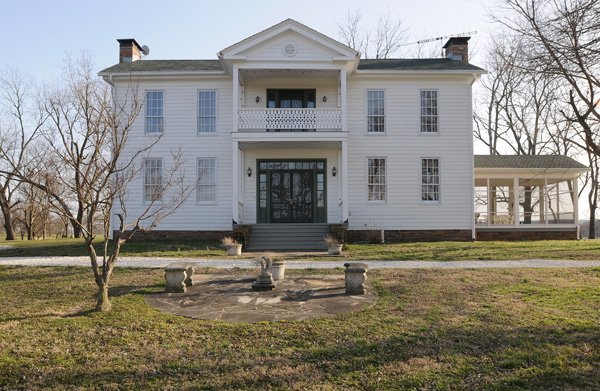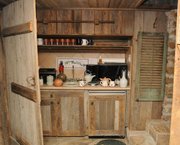By 1864, people across Northwest Arkansas were starving. Three years of the Civil War had left fields fallow, mills burned and stores ransacked.
A hungry face showed up at Col. Marcus LaRue Harrison’s office at Union headquarters in occupied Fayetteville nearly every day begging for whatever stores the Army could spare. Harrison could barely feed his own men, let alone the thousands of people caught in the middle of a raging firestorm.
Harrison wrote about the escalating humanitarian crisis to Lt. Col. A.W. Bishop, acting adjutant general of Arkansas, in December 1864: “I write this as a simple memorandum to guide you in your entreaties for the suffering women and children of Northwest Arkansas. There are thousands of old men, women and children left here yet. You know their condition.”
Harrison outlined a controversial idea that has been all but forgotten 150 years later. He told Bishop about his plan to form fortified colonies around Northwest Arkansas to house and feed anyone willing to take the oath of allegiance to the United States.
These colonies served as a means of protection in a region of divided loyalties. While Arkansas seceded from the Union, Northwest Arkansas was a hotbed of Union sentiment. So many Union men came streaming across the border from Northwest Arkansas into Missouri that Harrison convinced his superiors to allow him the radical move of forming a Union regiment of men from a disloyal state.
After Union successes at battles in Northwest Arkansas, many Union soldiers stationed at Fayetteville were forced to watch as nearby families tried to eke out an existence on war-ravaged land. Establishment of the colonies alleviated family concerns for many soldiers, thereby keeping them in the ranks and out of the fields.
The colonies also served as protection and a food source in a region that, after the major battles, was still rife with guerrilla warfare. Harrison’s post colonies were to start with 50 men “capable of bearing arms” that would settle on a large tract of abandoned land. Land was to be parceled out to families by vote, with “nothing in common, except defense and obedience to law,” Harrison wrote.
At A Glance
Northwest Arkansas Civil War Colonies
Col. Marcus LaRue Harrision, commander of the Union’s First Arkansas Cavalry Regiment at Fayetteville, organized fortified agricultural colonies to help feed and protect the region’s residents toward the end of the Civil War. The colonies were:
Benton County
• Bentonville: The colony was home to between 100 and 200 people led by Capt. Alfrey. Its location is not known.
• Pea Ridge: More than 40 people lived in the colony that was likely west of the battlefield.
Washington County
• Mountain: The colony was home to about 65 men with a large block house. It was possibly in the now defunct Mountain Township between West Fork and Cane Hill.
• Prairie: Run by Capt. George A. Cline, the colony was home to 85 men.
• Main Fork: Referring to the Main Fork of the White River, Civil War skirmish records note this area is eight miles east of Fayetteville. This colony may not have been fully established.
• Walnut Grove: This colony was organized only partially and was likely near Farmington.
• Union Valley: The colony was based out of the still-standing William Wilson plantation mansion on Ditmars Road northwest of Prairie Grove. It was home to more than 100 people led by Capt. Joseph R. Rutherford.
• Engles’ Mill: The Engles plantation house stands beside Arkansas 62 in Farmington between Bois D’Arc Street and Rhea’s Mill Road. The mill was along the creek that runs beside the house.
• Elm Spring: The colony was probably near present-day Elm Springs. It held about 39 men led by a Capt. Sanders.
• Mud Town: Mud Town was just east of Lowell, though the exact site isn’t known. A man surnamed Winningham was to settle the colony with 50 Union families returning from Missouri after December 1864.
• Mount Comfort: Led by a Capt. Shreve, the colony was likely in the Mount Comfort community in east Fayetteville. Reports said it had 35 men on good land.
• Oxford Bend: The Oxford Bend community is just west of Goshen.
• Middle Fork: The middle fork of the White River is near Elkins. The colony was only partially enrolled.
• West Fork: Led by Capt. B. Lewis, the colony was likely near present day West Fork. The 95 inhabitants did “good service against guerrillas,” Harrison wrote.
• Hog Eye: The Hogeye community is west of West Fork.
Madison County
• Huntsville: A Capt. Bivens led the 85 men stationed in the colony.
• Richland: The colony was on Thomas M. Johnson’s plantation east of Wesley near the intersection of Arkansas 74 and Arkansas 295 in the Drake’s Creek community. More than 200 people lived in the colony led by Capt. Bethel Counts.
• War Eagle: Near Huntsville, the colony was led by Capt. Elitle Haynes and home to 99 men.
• Brush Creek: The colony was at Vaughn’s Meeting House and led by a Capt. Wilkinson.
Source: Staff Report
“Harrison was constantly being asked by civilians for food, for protection,” said Alan Thompson, museum registrar at the Prairie Grove Battlefield State Park. “He thought if you could get all these people together and arm them, instead of one Farmer Joe, you’d have 100 that could fight off the bushwhackers.”
The settlements progressed quickly, with at least 14 set up in Washington County, two in Benton County and four in Madison County. The largest colony, Union Valley, was so successful Harrison claimed it would deliver 1,000 tons of hay to the Union Army in spring 1865.
Union Valley was at the site of the William Wilson plantation just southeast of the old Rhea’s Mill on what is now Ditmars Road near Prairie Grove. The original mansion began by Wilson in 1857 still stands alongside a carriage house. His descendants occupy the home.
Wilson was a Confederate sympathizer, one of many Confederates who fled to Texas under the face of Union occupation. Two of Wilson’s sons served in the Confederate Army, and one son joined the Union Army.
With its owner in Texas, Harrison commandeered the Wilson home and acreage for use as a colony. Joseph R. Rutherford, a Benton County native, was commissioned as captain and put in command of the home-guard company.
The colony became home to more than 100 people during the war. The group was well armed with rifles and ammunition, as records from the colony attest. Harrison wrote to wartime Arkansas Gov. Isaac Murphy, “They think they can whip 1,000 Rebels inside the fort.”
“I write this as a simple memorandum to guide you in your entreaties for the suffering women and children of Northwest Arkansas. There are thousands of old men, women and children left here yet. You know their condition.”
— Col. Marcus LaRue Harrison
Union Army officer
A colony roster lists many widows with children living in the colony and several men with sons in Rebel service. Three of the women have “husbands gone south,” while one was left by a “husband gone north.”
Those left behind faced a hardscrabble existence. Most, like those absent husbands, chose to move elsewhere. A special sheriff’s census conducted just after the war ended in 1865 showed Washington County’s population dropped from 15,000 in 1860 to around 5,000 five years later.
“A lot of the people just up and left,” Thompson said. “A lot of them went to Texas.”
Wives, widows and children of Union soldiers who lived on the colonies were allowed to purchase partial soldier rations from the Army at cost. A March 1865 general order issued by Harrison stipulated women were entitled to a three-fifths ration of fresh beef, three-fourths ration of soft bread, three-fourths ration of rice or hominy and one-half ration of tea or coffee and sugar. Children were allowed half a woman’s ration.
Destitute colonists not otherwise associated with the Union Army were entitled to the same rations, but they were charged transportation costs for the food.
The system was employed with vigor across Northwest Arkansas. The model was adopted in southern Arkansas counties as well. In addition to Union Valley, two of the colony sites have been uncovered by researchers. The Engles’ Mill colony was likely based near the home of William H. Engles, who owned a plantation house and mill in what is now Farmington.
His home still stands on Arkansas 62 between Bois D’Arc Street and Rhea’s Mill Road. A creek runs alongside the historic home that once fed the family’s grist mill.
The Richland colony was on Thomas M. Johnson’s plantation in Madison County. The tract is boxed by ridges and sits along Lollar’s Creek in the historic Drake’s Creek community east of Wesley.
Harrison wrote Richland was run by Capt. Bethel Counts and was home to 109 men in 1865. He said the colonists were “workers in every sense.”
Richard “Hank” Callico and his wife, Wynema, live across a dirt road from where the old Johnson plantation home once stood. Callico’s ancestors homesteaded the Drake’s Creek area, which has dwindled from a thriving crossroads with banks and mercantile shops down to a few scattered homes and a Church of Christ in the former schoolhouse.
He recalled the story his family told of Confederate soldiers coming to Drake’s Creek to conscript his grandfather.
“They were going to take him to camp,” Callico said. “He kept dragging back on his horse.”
When the soldiers told the elder Callico to hurry along, he said his horse was caught in grapevines.
“He was finally able to make a run for it. They never did catch him,” Callico said.
Callico remembers when the large, white, two-story house still stood next door with a porch that wrapped around three sides so the Johnsons could catch a breeze from any direction. He said he heard stories of a wounded Civil War soldier dying on that spacious front porch.
Callico said a Civil War buff from Harrison surveyed his land with a metal detector once and found many Civil War era bullets.
After a series of public meetings were held publicizing the colonies in spring 1865, Harrison exultantly wrote Murphy: “I have never known anything more enthusiastically taken hold of by our people than is our colony system.”
He claimed the meetings were attended by about 1,000 people in Fayetteville, 500 in Madison County and 200 in Benton County.
Not everyone was pleased with Harrison’s grand idea. His superior, Brig. Gen. Cyrus Bussey, wrote several letters to Bishop lambasting the colony system. He was suspicious of Harrison’s motives, claiming he was trying to position himself for a Congressional run and selling military provisions for his own profit.
He also noted an event that transpired at the Fayetteville meeting and hurt Harrison’s cause. Orders stipulated anyone living near a colony must join the colony or move. One of Harrison’s men, Maj. John I. Worthington, took that rule one step further during the Fayetteville meeting. He claimed anyone who chose not to join a colony would be shot.
History teacher Richard Bland wrote an article on Harrison’s life and said the meeting served to undermine his goals. Bland said his research turned up accounts from decendants of post colony residents who said their ancestors described the colonies as “prisons” and “concentration camps.”
Confederate sympathizers who hadn’t already left fled the area in fear their lives were in further danger.
Bussey continued working to undermine Harrison’s colonies up until the surrender of the Confederate forces west of the Mississippi River in May 1865. The announcement didn’t come a moment too soon. A letter from George A. Purdy, a lieutenant under Harrison, to Rutherford on April 14, 1865, said the commissary was completely empty at Fayetteville. Rations were not set to arrive for three days.
In the letter, Purdy jubilantly explains the firing Rutherford heard from Fayetteville was a celebration of Gen. Robert E. Lee’s surrender in Virginia.
“We today fire 200 guns in honor of this long-hoped-for event, the termination of this Rebellion. But a few days will elapse before all Confederate armies will cease to exist,” Purdy wrote. “We may be troubled for some time by the guerrillas, but the time is not far distant when we can return to our homes with safety, and beat our swords into plow shares, and our spears into pruning hooks.”
Most colonies disbanded at the end of the war, though some colonists stayed on to harvest crops that were planted in the spring. As surviving Confederates returned home from the war or from Texas and took the oath of amnesty, plantation homes and lands occupied by the Union Army were returned to their rightful owners.
Rutherford, however, was loath to leave Union Valley and the comforts of the Wilson plantation. Lafayette Gregg, a Fayetteville lawyer and Union commander, wrote to Rutherford on Wilson’s behalf. He reminded Rutherford that amnestied Confederates were entitled to their full property rights and suggested Harrison would advise Rutherford to give up his claim to the home.
“The military has once more given place to the Civil powers to settle all questions of property where a citizen is concerned,” Gregg wrote.
Rutherford eventually returned the home to the Wilson family. There is a legend he carved his name in an upstairs door. A date on the carving, however, looks to be from 1875 or 1895, long after Rutherford returned to Benton County.
Harrison went on to serve as a short-term mayor of Fayetteville before the backlash to Reconstruction kicked all Republicans out of office in the state for a century. He laid out the city of Harrison, which was named in his honor, and served much of the rest of his life in federal jobs in Washington.
The colonies he established left little physical mark on the land they occupied. But Thompson is working with local legislators to erect historical markers to remember Harrison’s idea and the controversial system that was home to the region’s war refugees.





